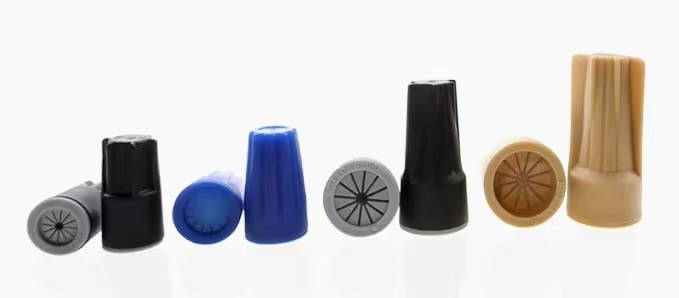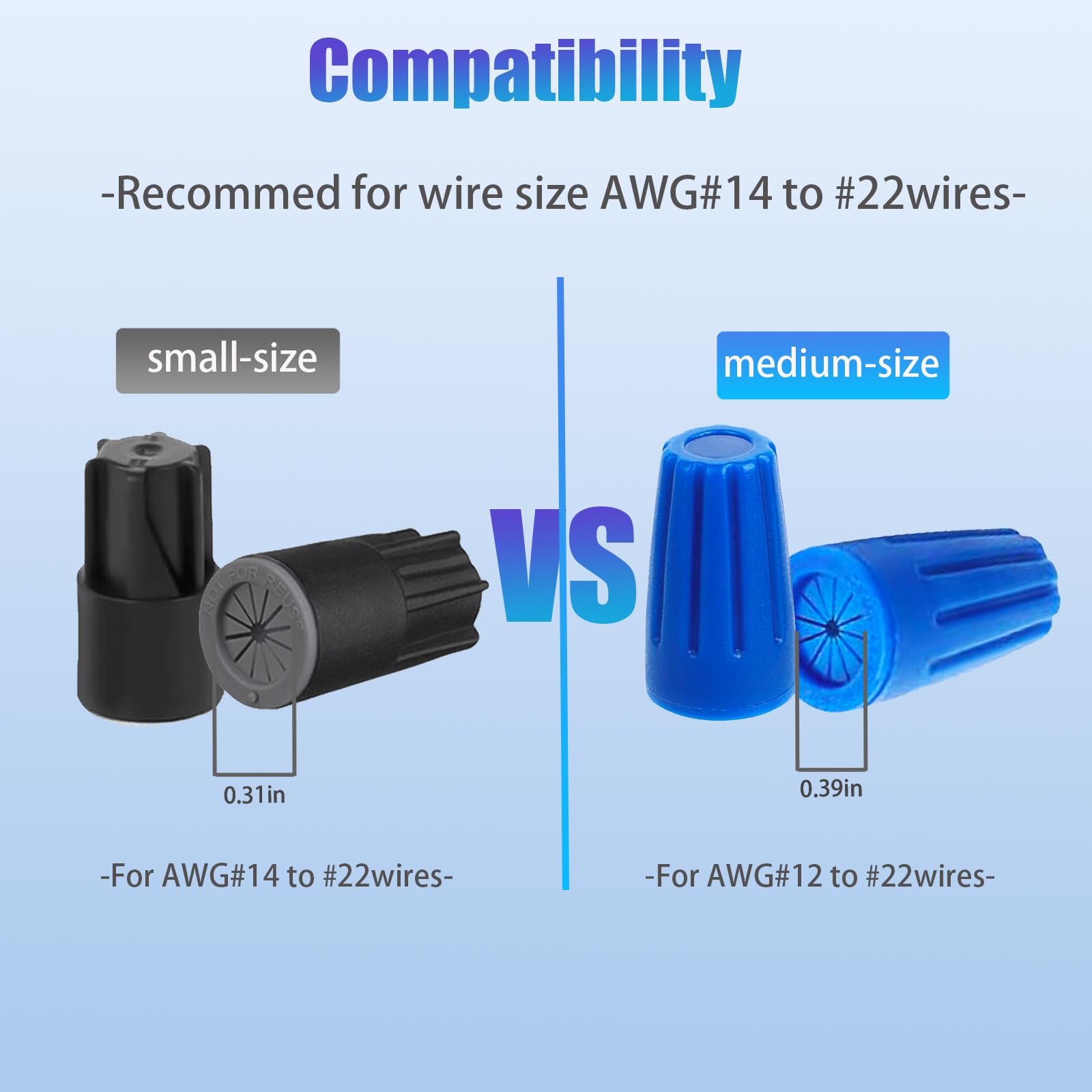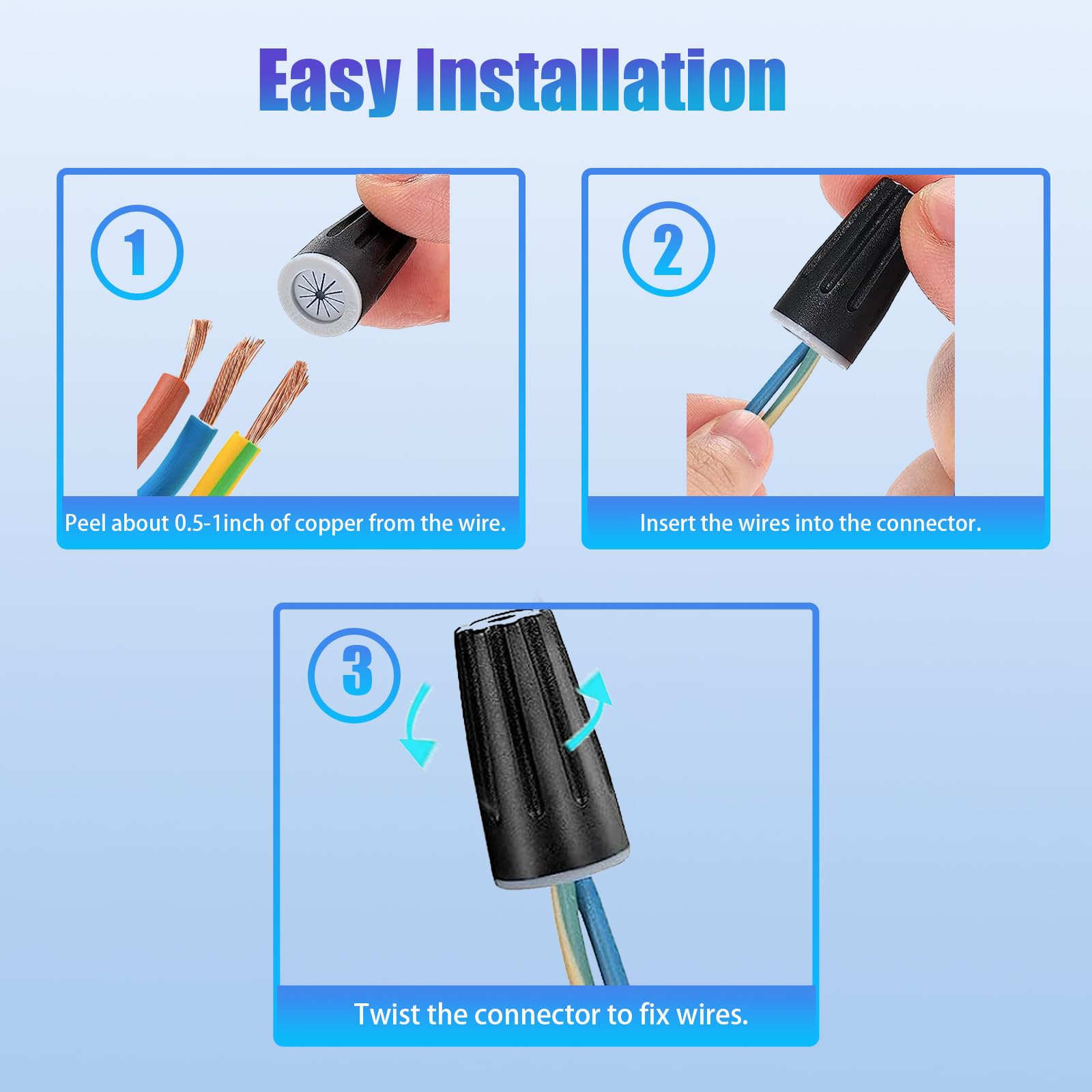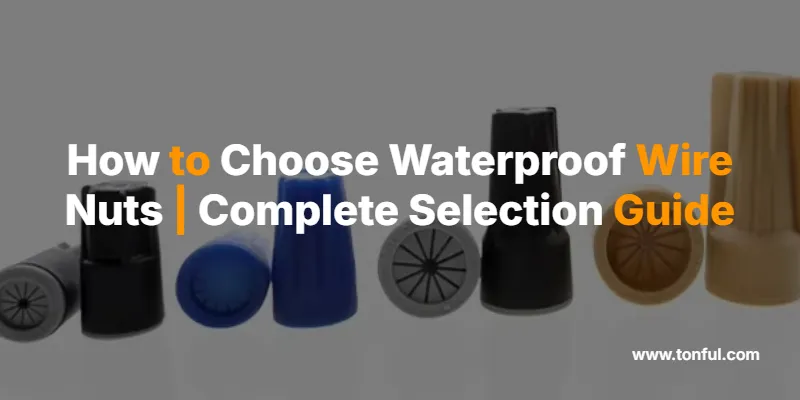Waterproof wire nuts are essential electrical connectors designed to protect wire connections from moisture, water, and environmental elements. You need waterproof wire nuts for any electrical connections exposed to wet conditions, outdoor installations, or high-humidity environments. The right waterproof wire nut prevents corrosion, electrical failures, and safety hazards while ensuring reliable long-term performance.
Understanding how to choose waterproof wire nuts properly can save you from costly repairs, electrical failures, and potential safety risks. This comprehensive guide covers everything you need to select, install, and maintain waterproof wire nuts for maximum protection and compliance.
What Are Waterproof Wire Nuts?

Waterproof wire nuts are electrical connectors specifically engineered with moisture-resistant materials and sealing properties to protect wire connections from water ingress. Unlike standard wire nuts, these connectors feature specialized designs including silicone-filled chambers, rubber gaskets, or heat-shrink sleeves that create watertight seals around joined wires.
Key Characteristics of Waterproof Wire Nuts
- Moisture barrier protection through sealed connector bodies
- Corrosion-resistant materials like marine-grade plastics or metals
- IP (Ingress Protection) ratings indicating water resistance levels
- Temperature stability for outdoor temperature fluctuations
- Chemical resistance against environmental contaminants
Waterproof vs Standard Wire Nuts: Key Differences
Here is a table that shows the essential differences between waterproof and standard wire nuts:
| Feature | Standard Wire Nuts | Waterproof Wire Nuts |
|---|---|---|
| Water Protection | None – moisture can enter freely | Complete water barrier with sealed design |
| Installation Environment | Indoor, dry locations only | Outdoor, wet, underground, marine applications |
| Material Construction | Basic plastic shell | Silicone-filled, rubber gaskets, or heat-shrink |
| Cost | $0.10-$0.50 each | $1.00-$5.00 each |
| Lifespan in Wet Conditions | Fails quickly, causes corrosion | 10-25 years with proper installation |
| Code Compliance | Not suitable for wet locations | Meets NEC Article 314 wet location requirements |
| Connection Security | Mechanical twist connection | Sealed mechanical + moisture barrier |
Expert Tip: Standard wire nuts used in wet conditions will fail within months, causing dangerous electrical faults and code violations. Always use properly rated waterproof connectors for any moisture exposure.
Types of Waterproof Wire Nuts
1. Silicone-Filled Wire Nuts
Best for: Underground direct burial and severe moisture conditions
- Pre-filled with waterproof silicone gel
- Self-sealing action during installation
- Temperature range: -40°F to +200°F
- Popular models: 3M DBY, King Innovation WeatherProof
2. Heat-Shrink Wire Nuts
Best for: Marine applications and high-vibration environments
- Dual-wall tubing with adhesive inner layer
- Heat activation creates permanent seal
- Provides mechanical strain relief
- Popular models: 3M Heat Shrink, TE Connectivity Raychem
3. Twist-On Waterproof Connectors
Best for: Above-ground outdoor installations
- Traditional twist-on design with rubber gaskets
- Quick installation without special tools
- Reusable for maintenance access
- Popular models: Ideal In-Sure, NSi WP Series
4. Grease-Filled Splice Kits
Best for: Underground utility connections
- Professional-grade moisture protection
- Includes wrapping tape and mastic
- Suitable for high-voltage applications
- Popular models: 3M Scotchcast, TE Connectivity
How to Choose the Right Waterproof Wire Nuts
Step 1: Determine Your Application Requirements
Identify the installation environment:
- Indoor wet locations (basements, crawl spaces)
- Outdoor above-ground (landscape lighting, HVAC)
- Underground burial (sprinkler systems, outdoor circuits)
- Marine environments (docks, boats, coastal areas)
Step 2: Check Wire Specifications

Match connector capacity to your wires:
| Wire Gauge Combination | Recommended Connector Size | Typical Applications |
|---|---|---|
| 14-12 AWG (2-3 wires) | Small waterproof nut | Landscape lighting, small fixtures |
| 12-10 AWG (2-4 wires) | Medium waterproof nut | Outdoor receptacles, HVAC connections |
| 10-8 AWG (2-3 wires) | Large waterproof nut | Pool equipment, large outdoor loads |
| 6 AWG and larger | Professional splice kit | Main service connections, heavy equipment |
Step 3: Verify IP Rating Requirements
IP (Ingress Protection) ratings indicate water resistance levels:
| IP Rating | Protection Level | Suitable Applications |
|---|---|---|
| IP65 | Water jets from any direction | Outdoor fixtures, exposed connections |
| IP67 | Immersion up to 1 meter | Underground splice boxes, flood-prone areas |
| IP68 | Continuous submersion | Direct burial, marine environments |
Safety Warning: Never use connectors with insufficient IP ratings for your environment. Water ingress can cause electrocution, fires, and equipment damage.
Step 4: Consider Temperature Requirements
Temperature ratings must exceed your environment:
- Standard range: -20°F to +150°F for most climates
- Extended range: -40°F to +200°F for extreme conditions
- Thermal cycling: Choose connectors rated for temperature fluctuations
Step 5: Evaluate Installation Method
Choose based on your skill level and access requirements:
- Tool-free twist-on: Quick installation, field serviceable
- Heat-shrink activation: Permanent seal, requires heat gun
- Mechanical compression: Professional installation, highest reliability
Installation Best Practices

Proper Installation Steps
- Strip wires to manufacturer specifications (typically 1/2″ to 5/8″)
- Clean wire ends with electrical contact cleaner
- Pre-twist solid wires clockwise before connector installation
- Apply connector firmly until wires bottom out completely
- Activate sealing mechanism (heat-shrink, compression, or twist)
- Inspect seal integrity for proper coverage and gaps
Expert Tip: Over-stripping wires reduces connection strength, while under-stripping prevents proper contact. Follow manufacturer strip length specifications exactly.
Common Installation Mistakes to Avoid
- Using standard wire nuts in wet locations
- Insufficient wire stripping or over-stripping
- Mixing wire types (aluminum with copper) without proper connectors
- Inadequate connector size for wire gauge combination
- Skipping pre-twisting step for solid conductors
- Installing without proper IP rating for environment
Code Compliance and Safety Requirements
National Electrical Code (NEC) Requirements
- Article 314.15: Wet locations require weatherproof enclosures and connections
- Article 110.14: Connections must be suitable for environment and conductor material
- Article 300.5: Underground installations require wet location rated components
Local Code Considerations
- Municipal amendments may have stricter requirements
- Inspection requirements for outdoor electrical work
- Permit needs for major outdoor electrical installations
Safety Warning: Always consult local electrical codes and obtain proper permits for electrical work. Improper installations can cause fires, electrocution, and code violations.
Troubleshooting Common Issues
Connection Failure Symptoms
| Problem | Likely Cause | Solution |
|---|---|---|
| Intermittent power loss | Loose connection or corrosion | Re-terminate with new waterproof connector |
| Visible corrosion on wires | Water ingress through failed seal | Replace with higher IP-rated connector |
| Connector melting or burning | Oversized wire gauge or loose connection | Use properly sized connector, ensure tight connection |
| Moisture inside connector | Damaged seal or wrong connector type | Replace with appropriate waterproof connector |
Maintenance Requirements
Annual inspection checklist:
- Visual inspection for cracks or damage
- Connection tightness verification
- Seal integrity assessment
- Corrosion signs on accessible wire ends
Selection Criteria for Different Applications

Landscape Lighting Systems
Recommended specifications:
- IP65 minimum rating for exposed connections
- Silicone-filled or twist-on waterproof nuts
- Temperature range: -20°F to +150°F
- Wire capacity: 12-14 AWG (2-4 wires)
Pool and Spa Equipment
Recommended specifications:
- IP67 minimum for potential submersion
- Marine-grade materials for chemical resistance
- Heat-shrink or professional splice kits
- NEMA 4X enclosure compatibility
Underground Installations
Recommended specifications:
- IP68 rating for continuous moisture exposure
- Direct burial rated components
- Silicone-filled or grease-filled splice kits
- UV resistance for shallow burial applications
Expert Tips for Maximum Performance
Professional Installation Tips:
- Always use dielectric grease on connections in marine environments
- Pre-twist solid conductors clockwise before connector installation
- Test connections with multimeter before sealing permanently
- Document installation locations for future maintenance access
Safety Considerations:
- Turn off power at breaker before making any connections
- Use GFCI protection for all outdoor electrical circuits
- Verify proper grounding for all outdoor installations
- Consider surge protection for valuable equipment
Cost Optimization Strategies:
- Buy waterproof connectors in bulk for large projects
- Choose reusable connectors for frequently serviced locations
- Invest in higher-quality connectors for critical applications
- Consider professional installation for complex underground work
Frequently Asked Questions
What makes a wire nut waterproof?
Waterproof wire nuts feature specialized sealing mechanisms including silicone gel filling, rubber gaskets, heat-activated adhesives, or compression seals that prevent water from reaching the wire connection point, unlike standard wire nuts that offer no moisture protection.
Can I use regular wire nuts outdoors if I put them in a waterproof box?
No, you must use waterproof wire nuts even inside weatherproof enclosures. Condensation and moisture can still enter enclosures, and the NEC requires wet location rated components throughout the connection system for proper code compliance and safety.
How long do waterproof wire nuts last in outdoor conditions?
Quality waterproof wire nuts properly installed can last 15-25 years in outdoor conditions. Lifespan depends on environmental factors like UV exposure, temperature cycling, chemical exposure, and installation quality. Regular inspection helps identify replacement needs.
What’s the difference between IP65, IP67, and IP68 ratings for wire nuts?
IP65 protects against water jets from any direction, suitable for exposed outdoor connections. IP67 withstands immersion up to 1 meter for 30 minutes, ideal for flood-prone areas. IP68 provides continuous submersion protection for direct burial and marine applications.
Can waterproof wire nuts be reused after removal?
Twist-on waterproof wire nuts with rubber gaskets can typically be reused if the sealing components remain intact. However, silicone-filled and heat-shrink types are single-use only, as removal destroys the waterproof seal and requires new connectors for proper protection.
Do I need special tools to install waterproof wire nuts?
Most waterproof wire nuts install with standard electrical tools – wire strippers and basic hand tools. Heat-shrink types require a heat gun for activation. Professional splice kits may need specialized crimping tools. Always follow manufacturer installation instructions for proper sealing.
What wire gauge combinations work with waterproof wire nuts?
Waterproof wire nuts are available for various gauge combinations. Small nuts handle 18-14 AWG (2-3 wires), medium nuts accommodate 14-12 AWG (2-4 wires), and large nuts manage 12-10 AWG (2-3 wires). Always verify specific connector ratings match your wire combination exactly.
Are waterproof wire nuts required by electrical code?
Yes, the National Electrical Code requires wet location rated components for any electrical connections exposed to moisture, including outdoor installations, underground circuits, and damp indoor locations. Using standard wire nuts in wet locations violates code and creates safety hazards.
Quick Reference Selection Guide
For quick waterproof wire nut selection, match your application to these recommendations:
Basic Outdoor Connections (Landscape Lighting)
- Type: Silicone-filled twist-on
- Rating: IP65 minimum
- Size: 12-14 AWG capacity
- Cost: $1-2 each
Underground Installations (Sprinkler Systems)
- Type: Silicone-filled or grease splice kit
- Rating: IP67/IP68
- Size: Match wire gauge exactly
- Cost: $2-5 each
Marine/Pool Applications (High Chemical Exposure)
- Type: Heat-shrink with adhesive
- Rating: IP68 + chemical resistance
- Size: 12-10 AWG typical
- Cost: $3-8 each
Professional/Commercial (High Reliability Required)
- Type: Mechanical splice kit with mastic
- Rating: IP68 + temperature rated
- Size: Engineered for specific application
- Cost: $10-50+ per connection
Conclusion
Choosing the right waterproof wire nuts requires careful consideration of your specific application, environmental conditions, and electrical requirements. The key factors are matching IP ratings to moisture exposure levels, selecting appropriate wire gauge capacity, and ensuring proper installation techniques for maximum protection.
Remember these critical points when selecting waterproof wire nuts:
- Never compromise on IP rating for your specific environment
- Follow NEC code requirements for wet location components
- Invest in quality connectors for long-term reliability
- Consider professional installation for complex or critical applications
For complex electrical installations or when in doubt about proper selection, consult a licensed electrician to ensure code compliance, safety, and optimal performance of your waterproof wire nut connections.

